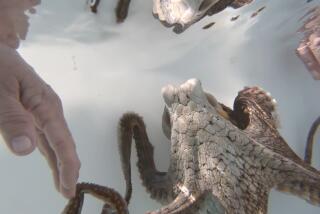Opossums Can Spread Parasite to Horses, So Take Precautions
- Share via
Question: We have horses where we live in Ventura. I’ve heard they can contract a disease from opossums.
What is this disease?
B.G.
Ventura
Answer: The disease is equine protozoal myeloencephalitis, or EPM, and is transmitted from opossums to horses when they eat or drink where infected opossums have defecated.
The organism responsible for EPM is a parasite, Sarcocystis neurona, a protozoan or microscopic single-cell organism. Opossums contract the parasites by eating infected birds and pass on the parasites through their feces. They do not become infected themselves.
Symptoms are ambiguous, often mimicking other health problems. But experts say that one notable clue is how the disease affects one side or part of the horse more than another.
According to Dr. Rob Franklin, veterinarian at the Humphrey, Giacopuzzi, Cox Equine Hospital in Ventura County, horses with the disease may appear drowsy and nonresponsive, have neurological symptoms in their faces or have trouble with balance and coordination.
A recent area study showed nearly 50% of horses have been exposed to the disease but don’t necessarily contract it. Both a blood test and spinal tap are necessary for a positive diagnosis.
Treatment takes a minimum of six months, involving a combination of antibiotics and coccidiostats, supportive therapy like anti-inflammatory drugs and even vitamin supplements.
Franklin said one-third of treated horses recover completely, one-third show improvement but may relapse later and one-third succumb to the disease.
EPM is not transmitted from horse to horse or to people. Because it’s tough to keep wild animals from mingling with domestic ones, preventing EPM can be difficult.
Here are a few prevention tips:
* Keep wild animals out of feed rooms and containers. Use standard rodent prevention techniques.
* Feed your horses heat-treated cereal grain and extruded feeds.
* Keep your stalls and barn clean.
* Keep tanks filled with fresh water and keep grain off the ground.
Gophers Leave Clues When They Dig Holes
Q: We have recently bought a new home on a view lot in the Stevenson Ranch area. Behind our house we have about a 200-foot slope. In January we had our backyard landscaped with a lawn and planters bordering it. Recently we found eight gopher holes in the lawn and planters.
The unique thing about these holes is that there is no dirt kicked up around them. Our neighbor has not landscaped his yard. Are the gophers attracted to our yard because of the fresh landscaping, and will we always have this problem living on the hillside?
T.S.
Stevenson Ranch
A: Although the conditions are ripe for gophers, it sounds an awful lot like you’ve got ground squirrels back there.
Here’s how to tell which is which:
Gophers make a telltale U-shaped mound of moist, sifted-looking dirt pushed up and out of the ground as a result of their tunneling.
Under the curve of the mound is a plugged hole that leads to an intricate network of underground tunnels terminating in other mounds or in eating and nesting chambers.
Gophers’ formidable teeth and claws help them to tunnel in hard, dry soil or moist, wet areas like lawns and gardens. I’ve noticed, though, that they prefer somewhat wetter areas that offer a wider range of fresh greens to munch on after a hard morning tunneling.
Other considerations for good gopher habitat are the right exchange between exhaled gas and the “outside” air and the potential for cave-ins.
Ground squirrels’ tunneling, on the other hand, creates no mounds, just holes like you describe (into which they scurry at the first sight of danger, like a human or a hawk).
By landscaping in the winter when ground squirrels hibernate, you may have inadvertently disturbed their rest and sent them into action.
The long-term prognosis isn’t good, considering the massive slope and where you live. Your decision to live on the edge of the wilderness will come with some drawbacks, one of which involves living more closely with your wild neighbors.
The squirrels may be a nuisance, but bobcats and coyotes will be a more serious problem. Lock up your pets at night, reduce the lawn area as much as possible to avoid a constant turf war and enjoy the view.
*
Got critter conflicts? Send your queries to wildlife biologist Andrea Kitay at P.O. Box 2489, Camarillo, CA 93011, or via e-mail to andrea@livingwithwildlife.com. Please include your name and city. Questions cannot be answered individually.
For a list of Wildlife Bulletins that provide sound advice on homeowner-wildlife conflicts ($4 each), send a stamped, self-addressed envelope to the above address or visit https://www.livingwithwildlife.com.






